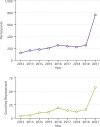A synopsis of global frontiers in fertility preservation
- PMID: 35870095
- PMCID: PMC9307970
- DOI: 10.1007/s10815-022-02570-5
A synopsis of global frontiers in fertility preservation
Erratum in
-
Correction to: A synopsis of global frontiers in fertility preservation.J Assist Reprod Genet. 2022 Aug;39(8):1713-1714. doi: 10.1007/s10815-022-02586-x. Epub 2022 Aug 3. J Assist Reprod Genet. 2022. PMID: 35920992 Free PMC article. No abstract available.
Abstract
Since 2007, the Oncofertility Consortium Annual Conference has brought together a diverse network of individuals from a wide range of backgrounds and professional levels to disseminate emerging basic and clinical research findings in fertility preservation. This network also developed enduring educational materials to accelerate the pace and quality of field-wide scientific communication. Between 2007 and 2019, the Oncofertility Consortium Annual Conference was held as an in-person event in Chicago, IL. The conference attracted approximately 250 attendees each year representing 20 countries around the world. In 2020, however, the COVID-19 pandemic disrupted this paradigm and precluded an in-person meeting. Nevertheless, there remained an undeniable demand for the oncofertility community to convene. To maintain the momentum of the field, the Oncofertility Consortium hosted a day-long virtual meeting on March 5, 2021, with the theme of "Oncofertility Around the Globe" to highlight the diversity of clinical care and translational research that is ongoing around the world in this discipline. This virtual meeting was hosted using the vFairs ® conference platform and allowed over 700 people to participate, many of whom were first-time conference attendees. The agenda featured concurrent sessions from presenters in six continents which provided attendees a complete overview of the field and furthered our mission to create a global community of oncofertility practice. This paper provides a synopsis of talks delivered at this event and highlights the new advances and frontiers in the fields of oncofertility and fertility preservation around the globe from clinical practice and patient-centered efforts to translational research.
Keywords: Cancer; Fertility preservation; Oncofertility.
© 2022. The Author(s), under exclusive licence to Springer Science+Business Media, LLC, part of Springer Nature.
Conflict of interest statement
The authors declare no competing interests.
Figures



References
-
- Armstrong GT, Yasui Y, Robison LL. Reduction in late mortality after childhood cancer. N Engl J Med. 2016;375(3):290–292. - PubMed
Publication types
MeSH terms
Grants and funding
LinkOut - more resources
Full Text Sources
Medical

